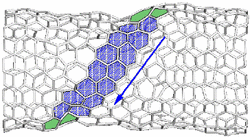Stretching Nanotubes

Since the discovery of carbon nanotubes in 1991, physicists and engineers have been trumpeting their potentially revolutionary uses in high-strength materials and new microscopic devices. Researchers hope to make these all-carbon cylindrical molecules into superstrong fibers and microscopic wires, but because the experiments are difficult, the mechanical properties of nanotubes are not well-understood. In the 23 November PRL a team reports on the first full, atom-by-atom computer simulations of the responses to mechanical stress of a wide variety of nanotube structures. They found that at high temperatures some nanotube structures don’t break initially, but transform gradually into longer, smaller-diameter tubes, an unexpected behavior that may be useful for making nanotube-based electronic devices.
To make a nanotube, start with the “honeycomb” structure of graphite–a sheet of carbon atoms whose bonds form a hexagonal pattern–and then roll up the sheet into a tube. Of course, you can roll at any angle with respect to the honeycomb and make the tube any diameter you choose. These two parameters–angle and diameter–determine the specific type of nanotube that is formed, and its properties depend strongly on this geometry. If you cleanly cut the tube perpendicular to its axis and find hexagon edges all the way around the circumference (as opposed to corners), it’s called an “armchair” tube. A “zigzag” tube would have the hexagons rotated by 90 degrees, so that the corners of the hexagons point out at the tube edge. Of course, many other orientations in between these two are possible.
Marco Buongiorno Nardelli and his colleagues at North Carolina State University in Raleigh wanted to study the most basic mechanical properties of nanotubes, as one would for any material. “You have a bar, and you want to know how much you can put on it before it breaks,” says Nardelli. With their detailed computer model, which calculates the influence of each atom in a chunk of tube on every other atom, they examined the effects of quickly stretching a tube along its axis by a fixed amount.
For low temperatures and large stretches, the tubes broke, but for high temperatures and moderate stretches (above 1300 K and strains near 10%), they observed “plastic” deformation of tubes with a wide range of structures. In armchair tubes, the stretching created heptagons and pentagons that propagated through the structure, reorienting the hexagons as they moved. According to the simulations, these reorientations can gradually turn armchair tubes into zigzag tubes, which break if the diameter is above 1.1 nm . But for tubes smaller than that, the deformation and reorientation can reduce the diameter and allow zigzag tubes to transform back into armchair tubes. These smaller tubes can continue to lengthen, shrink in diameter, and transform from one structure to another until they reach the smallest possible nanotube diameter.
Buongiorno Nardelli admits that the surprising ductile behavior he and his colleagues discovered occurs at such high temperatures that it is unlikely to directly affect the use of nanotubes in superstrong fibers. But he says the work provides basic information on their mechanical properties and suggests a way to manufacture nanotubes with precisely defined structures. Varying the structure along a tube varies the electronic properties, he says, which means the heat-and-stretch treatment could be used to make the equivalent of semiconductor junctions, the basic elements of digital electronics.
Steven Louie of the University of California at Berkeley finds the results “fascinating” and of “fundamental importance” to applications. He notes that nanotube electronic properties are already known to depend sensitively on their geometry; this paper shows that geometry also strongly influences mechanical responses. “The carbon nanotubes are once again proven to be a fascinating new class of materials with unexpected properties,” says Louie.


